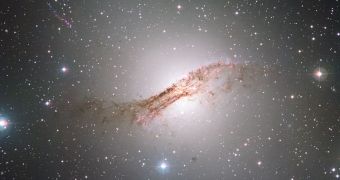Astronomers at the European Southern Observatory (ESO) have produced the most exquisite, deep view of Centaurus A, one of the most spectacular and heavily investigated objects in the night sky.
In order to snap this image, scientists used the Wide Field Imager (WFI) instrument, which is installed on the MPG/ESO 2.2-meter telescope, at the ESO La Silla Observatory, in the Chilean Andes.
Total exposure time for the WFI instrument was 50 hours. This enabled experts to collect a wealth of data, which they then included in this new image. The Centaurus A galaxy, also designated NGC 5128, was first discovered back on August 4, 1826.
It lies in the Centaurus constellation, and represents the brightest source of radio waves in the cosmic formation. It is located relatively close to Earth, at a distance of just 12 million light-years away.
Starting in the 1950s, astronomers began proposing the existence of a very large black hole at the core of the galaxy. This is the only possible explanation for its extremely bright nucleus, the strong radio emissions it generates and the massive jets that it spews out.
The supermassive black hole at its core is now believed to be around 100 million times heavier than our Sun. It could be that Centaurus A's radio emissions are produced by matter falling through the object's event horizon, while becoming super-heated in the process.
According to astronomers, the elongated shape of the galaxy's fainter outer parts indicates an elliptical format. Billions of cool, old stars had already been discovered inside Centaurus A. But the galaxy also has a massive band of dark material across its surface, which sets it apart from other elliptical galaxies.
“Extending from the galaxy to the upper left corner of the image are two groups of reddish filaments, which are roughly lined up with the huge jets that are prominent in radio images. Both sets of filaments are stellar nurseries, containing hot young stars,” an ESO press release says.
“Above the left side of the dusty band, we find the inner filaments, lying about 30 000 light-years away of the nucleus. Further out, around 65,000 light-years away from the galaxy’s nucleus and close to the upper left corner of the image, the outer filaments are visible,” the statement adds.

 14 DAY TRIAL //
14 DAY TRIAL //